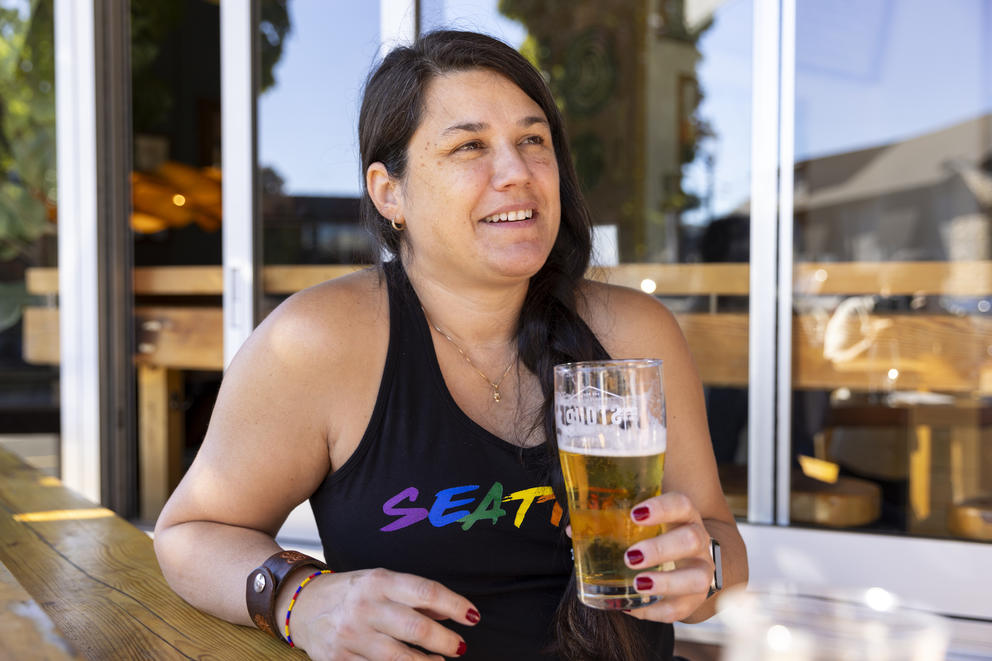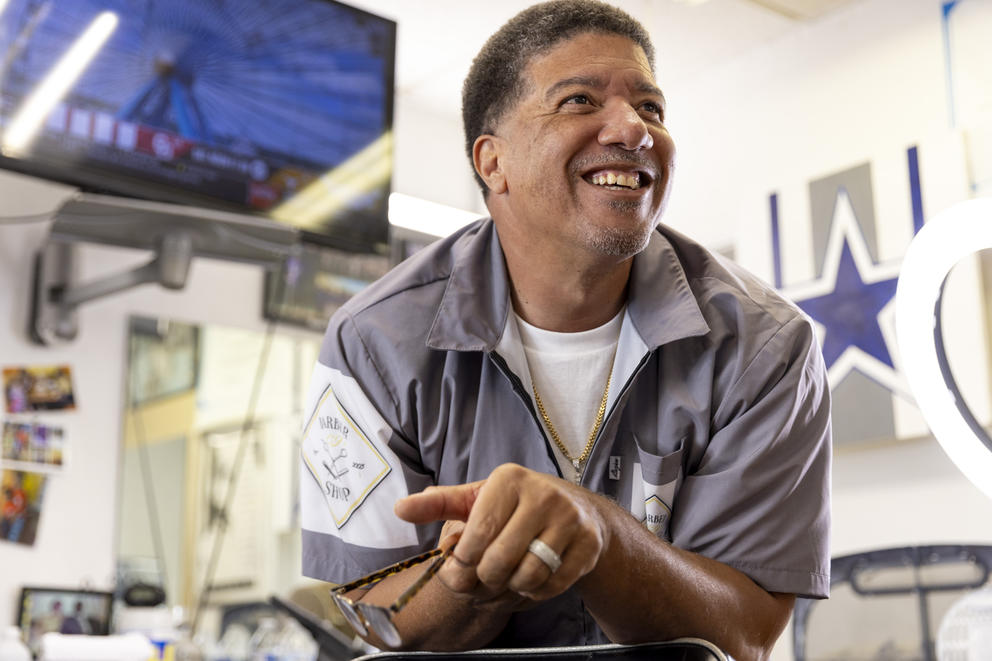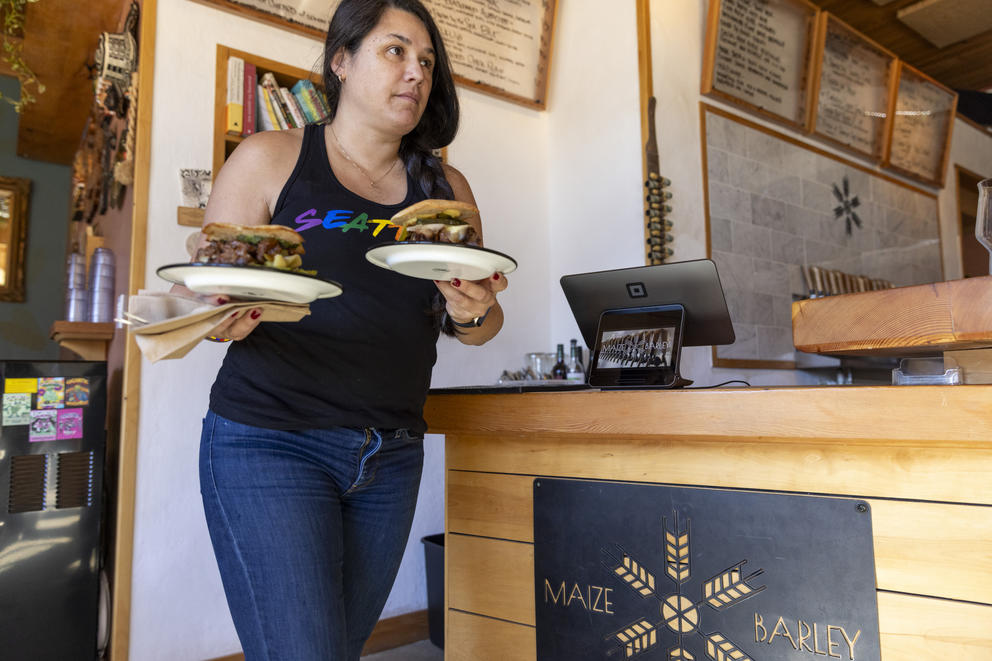“He is the chef, I do everything else,” Forteza said. “The joke of being a brewer is it’s like half janitor work.”
Forteza and her husband opened Maize & Barley, a petite, Caribbean-inspired kitchen and bar on Edmonds’ Main Street in mid-2019. It had been open less than a year when the coronavirus upended the world. Forteza recalled feeling overwhelmed at times by the financial challenges of steering her newborn bar through the chaos of COVID-19.
“I can go down beer rabbit style holes all day long, but … you want to talk about percentages of labor and all of that, those are still learning curves,” she said.
The couple wasn’t yet earning a salary from the bar when it was forced to shutter. In the difficult months that followed, they ultimately resorted to draining their daughter’s college fund to continue paying their mortgage during the worst of the pandemic. It was a horrible choice to make, said Forteza, a first-generation child of Caribbean immigrants who was the first in her family to obtain higher education.
The bar also survived in part thanks to $17,500 in grants from Washington state. With just three employees and uniquely hampered by COVID-19 restrictions, Forteza’s neighborhood restaurant was the type of small business lawmakers envisioned the Working Washington program supporting.
“Do I think it was enough? Lord no,” Forteza said. “But it allowed us to pay our rent … It bought us time.”
Since 2020, the state Department of Commerce has funneled close to a half-billion dollars in federal aid directly to more than 25,000 businesses across Washington, with fewer strings and less transparency than other pandemic stimulus efforts like the Paycheck Protection Program (PPP). Unlike federal programs, recipient data for the vast majority of the state’s business grants has not been posted publicly. Crosscut filed records requests to obtain individual grant amounts, which are now available to search below and in our Follow the Funds guide.
State lawmakers and finance officials positioned the Working Washington stimulus program as plugging a gap for small businesses passed over by federal relief efforts and still struggling amid COVID-19 restrictions, some of which continued into 2021. In addition to capping the size of businesses eligible to apply, officials also directed the Department of Commerce to prioritize “historically disadvantaged” businesses as well as those owned by Black and Indigenous people and people of color.
This story is a part of Crosscut’s WA Recovery Watch, an investigative project tracking federal dollars in Washington state.
Whether the program succeeded in targeting small or disadvantaged businesses remains unclear, in part due to inconsistent tracking of recipient data by Commerce, which could not cite any equity metrics it used to evaluate the distribution of funds. A Crosscut analysis of the data found Commerce awarded millions to large corporate chains. King County businesses received an outsized proportion of funding compared to its share of the state population. And just 5% of grants went to Black-owned businesses, though rates rose in later rounds.
“We can always improve processes and programs,” a Commerce spokesperson wrote in an email, “especially in unprecedented times like the partial shutdown of an entire economy during a global pandemic.”
‘We tried to move very quickly’
Working Washington grants went out to businesses over multiple rounds, beginning with a $10 million first round in April 2020. Funds came primarily from the CARES Act and American Rescue Plan Act. As federal aid continued to flow, lawmakers scaled up the program, eventually budgeting a $234 million fourth round. The state most recently awarded $79 million in stimulus grants targeted to hospitality businesses in July.
State officials initially limited grant funds to businesses with 10 employees or less, but that quickly expanded to include businesses with up to $5 million in revenue. Washington state grants were smaller than PPP, averaging just under $18,000, though some companies received multiple awards across different rounds.
“We were operating under emergency orders,” agency spokesperson Penny Thomas said. “It happened very quickly and we tried to move very quickly.”
Compared to federal Small Business Administration programs like PPP, state grant programs aimed to simplify the application process. The funds were presented up front as grants rather than potentially forgivable loans, and came with fewer spending limitations. Like many others, Working Washington did not require the majority of the money go toward staff payroll, a critical feature of PPP.
Business owners told Crosscut they used grant funds to pay rent and buy COVID-related supplies like masks, gloves and dividers. They submitted receipts to Commerce to prove their expenses were eligible.
Commerce officials said the agency distributed the initial round of awards, but then hired third-party contractors such as app software company Submittable, the nonprofit Grow America (formerly the National Development Council) and county-level Associate Economic Development Organizations to administer all following rounds. Officials recently declined to provide the contracts for that work. A records request filed by Crosscut for that information has not yet been returned.
Officials noted the maximum grant amounts, selection criteria, application process and other elements of the grant program changed and evolved across separate rounds, making consistent comparisons difficult. Commerce has already removed many of the grant application guidelines and award summaries from its website.
Thomas said she was not aware of any independent review or analysis of the program’s distribution process for the nearly $500 million in grants.
The Office of the Washington State Auditor does review spending practices and check sample transactions on state spending of federal dollars each year. In 2021, the State Auditor’s office cited Commerce as part of a broad review of CARES Act funds, finding it failed to comply with federal requirements regarding risk assessments of subrecipients. In a written response, Commerce argued that the need to get Working Washington grants out quickly justified the agency’s reliance on previous, outdated risk assessments.
“In some cases as with Working Washington … we had less than 45 days to develop program guidance, market, and award $270 million,” Commerce’s audit response stated. “This was an extreme challenge for our staff; however, we were able to meet it, to serve our small businesses in Washington State.”
Repeat awards to chains
Payment data collected by the state and shared with Crosscut details more than $494 million distributed via more than 28,000 awards in the various rounds of Working Washington and Hospitality grants. The largest single awards topped out at $171,422 during the most recent round, targeted to restaurants, bars and hotels in July. The smallest recorded grant went to a beauty salon in Dayton, Columbia County, for $40.26.
While Commerce previously published some recipient names and grant totals for individual counties or rounds, the newly released data offer an unprecedented look at the specific dollar amounts, repeat recipients and owner demographics of these awards. Crosscut also found a number of limitations on the data including popular businesses listed under obscure LLCs, different business identifiers used across different rounds, inconsistent demographic collection and rare instances in which data did not match its described category.
King County comprises 30% of the state’s population, but businesses located there pulled in 40% of Working Washington funds. In the recent hospitality-focused round, King County businesses won more than half of all grant dollars for the state.
A Commerce spokesperson wrote in an email that the geographic disparity can be explained by the higher density of businesses in King County compared to the rest of the state.
Local restaurant groups ranked among the top grossing recipients. Ethan Stowell Restaurants, which operates more than a dozen restaurants in Seattle and has opened outposts in Spokane and New York in recent years, took in more than $400,000 across multiple awards. In an interview, Stowell, the founder and CEO, said that lingering pandemic and inflationary impacts continue to challenge restaurants of all sizes, which were hit first and worst by COVID-19. Working Washington’s impact was modest compared to PPP, he estimated, covering maybe a few weeks of staff salaries.
“Thirty thousand per restaurant will not dictate whether the restaurant survives,” Stowell said. “But … it does help out for sure on making sure that payroll is covered, vendors are paid on time or early, all those things.”
Despite lawmakers’ instructions to limit eligibility to firms with less than $5 million in revenue, Commerce awarded millions to corporate conglomerates that applied multiple times on behalf of individual locations.
The highest-grossing named recipient, Karen Carter, identified themself as the CFO for a company incorporated in Washington as Big Horns Enterprises. State data link Big Horns Enterprises to Afterburn Coaching LLC, a Texas-based company that operates what it describes in job listings as “one of the largest independently owned” franchises of Orange Theory Fitness gyms in Seattle, Texas and Florida. In Round 4, Carter applied 19 times under different business names tied to the company’s Washington locations, ultimately collecting nearly $350,000. And in Round 3, an applicant named John Bellamy had also applied 17 times on behalf of the company, receiving $200,000. The company also received $4 million in PPP loans.
Similarly, Evergreen Restaurant Group – which operates Outback Steakhouse restaurants across the Northwest – received $510,000 across 30 awards. Unlike some other companies, it used virtually the same business name for each application – Evergreen Restaurant LLC – followed by a different four-digit number. Evergreen reported over $45 million in revenue in 2019, suggesting it would have been too large to qualify were it considered as one entity. It also collected $9 million in forgiven PPP loans, according to ProPublica.
Neither company returned requests for comment.
The Department of Commerce did not consider whether applicants were part of a larger corporate entity, even in cases where the revenue of the parent company exceeded the $5 million cap set by the legislature, Thomas wrote in an email.
“Across all rounds,” Thomas wrote, “there was no requirement to apply ownership structure as an eligibility criteria.”
State Sen. Lynda Wilson, a Republican representing Vancouver and a ranking member on the Ways and Means Committee, said Commerce could have done more to identify applicants that legislators did not intend to qualify.
“If Commerce had done a better job of tracking the applicants from the start, we could have amended the language to explicitly address the ownership structure and ensure the program worked as intended,” Wilson wrote in an email to Crosscut.
Owner Cliff “C.J.” Jones of C.J.’s Barbershop in Lynnwood wishes football player David Esponda, 16, of Lynnwood well after cutting his hair before his homecoming game on Friday, Oct. 6, 2023. Jones was able to secure two Working Washington grants, totaling $20,000, that helped him keep his shop open through the pandemic. (Jason Redmond for Crosscut)
Barriers and equity efforts
Cliff “CJ” Jones likes to talk to his clients while he cuts their hair. On a recent Friday, two high school athletes were getting fresh cuts for that night’s Homecoming game, and Jones grilled them about their grade point averages: One said he had a 3.6, the other said he didn’t know.
“See, that’s the wrong answer, man,” Jones said. “If you had a 3.6, you would know it.”
Like restaurants, barbershops were hard-hit by the pandemic. Jones said he didn’t qualify for a PPP loan because his stylists were technically independent contractors rather than employees. But he did receive a combined $20,000 from two Working Washington grants, which helped pay the rent on the shop, which shares a building with a brake repair garage off Highway 99 in Lynnwood.
State officials sought to prioritize businesses that were the most impacted by COVID-19, especially those owned by “historically disadvantaged” groups for whom the pandemic widened inequalities. Research on PPP has found that banks were less likely to issue loans to Black and Latino-owned firms, and businesses in majority-Black, Latino and Asian neighborhoods received PPP loans at lower rates than in majority-white neighborhoods.
Some business owners of color struggled to access credit before the pandemic, in part due to a lack of relationships with lenders and technical knowledge of the process, said Alice Park of the Equitable Recovery and Reconciliation Alliance. Some Black entrepreneurs were also wary of taking on debt due to experiences with predatory lending or a historical association with enslavement, Park said.
Victor Cerdeneta, business opportunity center manager for El Centro de la Raza, said some in the Hispanic community see debt as taboo and worried about what conditions might be attached. PPP required a Social Security number, which prevented undocumented entrepreneurs from applying.
Immigrant business owners sometimes struggled with online applications. Tina Hong, who immigrated from Korea and runs a teriyaki restaurant in Everett, told Crosscut she received funding in one round but was later rejected in another because she couldn’t find her restaurant’s Unique Entity Identification (UEI) number, a federal code required to apply. If the state had had a Korean speaker she could talk to, it would have helped her access the much-needed support, Hong said.
In spending memos and legislative appropriations bills, state lawmakers explicitly instructed the Department of Commerce to target Working Washington funds to business owners from disadvantaged groups, specifically Black and Indigenous entrepreneurs who missed out on the first round of PPP. It’s not clear if that effort was successful.
Conclusions about Working Washington grant distribution by race are difficult to draw. The question format changed each round, and data on applicants’ racial and ethnic identities was not collected in every round. Commerce officials say they believe that numbers of applicants self-attesting to marginalized groups may be underreported due to fear of discrimination.
Rounds 3, 4 and 5 represent 95% of total Working Washington grant funds. Within those rounds, roughly 5% of grant recipient businesses identified themselves as Black-owned. The most recent U.S. Census indicates African-Americans make up 4.6% of Washington residents while the Small Business Administration estimates Black people own 4% of Washington businesses.
About 3% of Working Washington grants went to businesses that identified as Native American-owned, Crosscut found. Native Americans make up 2% of Washington residents but own less than half of 1% of Washington businesses, according to SBA data.
Hispanic/Latino-owned businesses accounted for about 10% of grants in rounds 3, 4 and 5. About 5.5% of Washington businesses are Latino-owned, the SBA estimates, though Latinos make up nearly 14% of Washington residents according to the 2020 Census.
Asian-owned businesses were awarded about 28% of grants in those rounds. Asian-Americans make up 10.5% of Washington’s population and own 9.5% of businesses, federal data show.
Find tools and resources in Crosscut’s Follow the Funds guide to track down federal recovery spending in your community.
The share of grants awarded to minority business owners rose significantly in Round 5, when Commerce appears to have prioritized applicants who self-identified as minority, LGBTQ+, women or veterans. In Round 5, 17% of grants went to Black-owned businesses, 10% to Native American-owned businesses, and another 17% to Hispanic/Latino-owned businesses.
After the fourth round of grants went out in May 2021, Commerce sent out a press release highlighting the agency’s commitment to supporting disadvantaged business owners.
“We continue to focus our grant programs on sectors most disproportionately impacted or businesses most likely to be left out of federal aid programs,” read a statement attributed to then-director Lisa Brown, “hoping to minimize the risk of a ‘k-shaped recovery’ where some succeed more easily while others are left behind.”
Across Rounds 1-5, approximately 39% of grant awards either did not collect demographic information or applicants declined to claim any minority-ownership status. According to the available data, about 37% of grants, or more than $162 million, went to woman-owned businesses. Almost 4.4% of grants went to veteran-owned businesses, and more than 1,200 went to businesses that identified as LGBTQ+-owned.
In an interview, Keith Swenson, deputy director of the Office of Economic Development and Competitiveness within the Department of Commerce, highlighted the agency’s creation in 2020 of a “Small Business Resiliency Network” which aimed to make culturally relevant technical assistance resources more available to entrepreneurs from disadvantaged communities.
But Swenson could not say what metrics the department used to evaluate whether grant money was equitably distributed across racial groups, because the application questions asking about race and minority status were voluntary. He also questioned whether conclusions drawn about the program’s equity from the data his department provided were valid, calling it “dangerous” to interpret the data that way.
When asked if Commerce could say with any confidence whether the agency distributed the funds equitably across racial and ethnic groups, Swenson said he didn’t know. He also couldn’t say whether Commerce prioritized owners from disadvantaged groups, as legislators and the Office of Financial Management directed them to when it allocated the funds.
“Can I look at you in the eye and say we know definitively off those numbers?” Swenson said. “I can’t.”
Relief for hard-hit hospitality
The last round of business relief checks went out in July, in a $79 million round targeted to hospitality businesses.
The money was budgeted in 2022 but not distributed for more than a year. Anthony Anton, CEO of the Washington Hospitality Association, called the delay frustrating for businesses that went under during that time and potentially could have been saved had the funds come out earlier.
“The people who needed it were no longer there,” he said.
Restaurants were eligible for the Restaurant Revitalization Fund, a $28 billion federal program created in 2021. But that money disappeared quickly, offering up to $10 million to some restaurants while leaving many smaller and more rural establishments with nothing, as Crosscut reported last year.
One of the biggest challenges that hampered early rounds of Working Washington was a buggy software system that would boot out applicants, Anton recalls hearing from many of his members. While that particular quirk was eventually addressed by new software, Anton’s impression was that technical issues and constant changes to the process each round created confusion and frustration for some applicants.
“I can’t tell if it went through. I went back in but then the update made it look like we applied twice and now we got rejected,” Anton recalls business owners telling him about early rounds. “Commerce tried to get better each time,” he said of the successive funding rounds, “but I think we’d all acknowledge that a couple of them struggled.”
Economists have also questioned why states continue to utilize fiscal stimulus programs in an economy that by many measures has made a robust recovery, with strong employment and federal officials shifting their focus to taming inflation.
“It’s hard to rationalize relief grants in 2023,” said Gabriel Chodorow-Reich, a professor of economics studying state pandemic business relief efforts at Harvard University. “If there’s stimulus happening, it’s going to be counteracted by what the federal reserve is doing. …Washington [state] might be able to boost employment a little bit, but that’s going to come with higher inflation.”
For entrepreneurs like Forteza, the details of each relief program’s successes and shortcomings are less important than the fact that her bar is still open. She said she applied for the recent hospitality round but didn’t receive money – because, she suspects, her business didn’t show big enough losses between when it opened in 2019 and when the pandemic hit.
The pandemic changed many things for Forteza. Within weeks of lockdown, she was diagnosed with breast cancer. Her immunocompromised state made confrontations with customers over masking even more personal, she said. The restaurant she opened in order to bring people together now sparked conflict.
Forteza eventually recovered. She and her husband decided to close on Sundays, which has given him more time to coach their daughter’s volleyball team. She said the whole experience – COVID, cancer, the bar – has led her to feel more content with the small slice of the world she can influence. The relief grants, she said, were one small part of helping her hold on to that world.
“It’s not a lot of money,” she said, “but it meant a lot in that moment.”
Correction: A previous version of this story misstated the percentage of Black, Asian and Hispanic/Latino residents in Washington state as calculated by the U.S. Census. That information has been updated.
Get the latest investigative news
A newsletter for resources, data and behind-the-scenes insight into investigative efforts.










